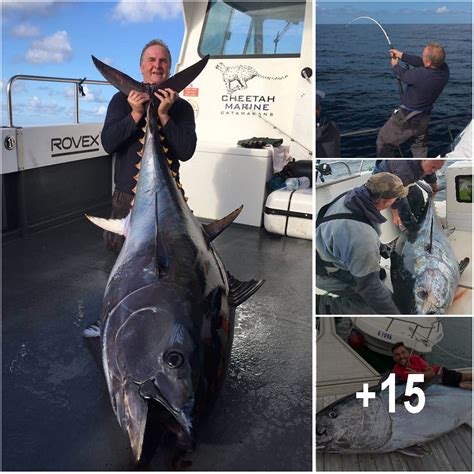
A fisherman in Louisiana has reeled in a potential world-record-breaking alligator gar, a monstrous fish that could shatter existing records. Dustin Muffett caught the massive gar in Toledo Bend Reservoir, near the Texas border, leaving him and seasoned anglers astounded by its size and weight. The catch is currently undergoing verification to determine if it surpasses the current world record.
Dustin Muffett, an experienced fisherman, encountered the alligator gar while fishing in the Toledo Bend Reservoir, a large reservoir straddling the border between Texas and Louisiana. Muffett stated, “It’s incredible! I knew it was big, but I didn’t realize it was this big.” He battled the fish for an extended period before successfully landing it, with the assistance of his fishing companions. The initial assessment suggests that the gar is a potential record-breaker, exceeding the weight and length of previous documented catches.
The alligator gar is one of the largest freshwater fish in North America, known for its distinctive alligator-like snout and formidable size. These apex predators inhabit rivers, bayous, and reservoirs throughout the southern United States and into Mexico. They are known for their ambush-style hunting techniques and their ability to thrive in a variety of aquatic environments. The species has faced population declines in the past due to overfishing and habitat loss but has seen a resurgence in recent years thanks to conservation efforts.
The current world record for the largest alligator gar caught stands at 327 pounds, caught in 2011 in Texas. Muffett’s catch is currently being evaluated by officials to determine its official weight, length, and other measurements. The process involves a meticulous review of the evidence, including photographs, videos, and witness testimonies. If verified, Muffett’s alligator gar will be recognized as the new world record holder, cementing his place in fishing history.
The news of Muffett’s catch has generated considerable excitement within the fishing community and beyond. Anglers from around the world have expressed their admiration for the impressive specimen and the skill required to land such a formidable fish. The catch has also sparked renewed interest in alligator gar conservation and the importance of protecting their habitat. Experts emphasize the need for sustainable fishing practices to ensure the long-term health of alligator gar populations and the ecosystems they inhabit.
The Louisiana Department of Wildlife and Fisheries is actively involved in the verification process and is working to ensure that all necessary protocols are followed. The department recognizes the significance of Muffett’s catch and its potential impact on the state’s fishing reputation. The department is also using the opportunity to educate the public about alligator gar biology, conservation, and responsible fishing practices.
Muffett’s catch serves as a reminder of the incredible biodiversity found in the waterways of Louisiana and the importance of responsible stewardship of these natural resources. The story of the giant alligator gar is a testament to the enduring allure of fishing and the potential for anglers to encounter truly remarkable creatures in the wild.
The impact of this record-breaking catch extends beyond the immediate excitement of the fishing community. It highlights the success of conservation efforts aimed at restoring alligator gar populations and preserving their habitat. The increased awareness generated by the catch can further promote responsible fishing practices and encourage the protection of these magnificent fish for future generations.
Muffett intends to donate the alligator gar to a local research institution or museum for further study and display. This decision reflects his commitment to conservation and his desire to share the wonder of his catch with others. The gar will provide valuable insights into the species’ biology, genetics, and ecology, contributing to a deeper understanding of these fascinating creatures.
The story of the giant alligator gar serves as an inspiration for anglers and conservationists alike. It demonstrates the potential for record-breaking catches and the importance of protecting the natural world. Muffett’s catch is a reminder that there are still wonders to be discovered in the wild and that responsible stewardship is essential for preserving these treasures for future generations.
Further Details and Context
Alligator gar are indeed impressive creatures, often referred to as “living fossils” due to their ancient lineage. They have existed for over 100 million years, dating back to the Cretaceous period. Their physical characteristics are quite distinctive. They possess a long, cylindrical body covered in diamond-shaped, interlocking ganoid scales, which act as a protective armor. Their most prominent feature is their elongated snout filled with sharp, needle-like teeth, perfectly adapted for grasping and holding onto their prey.
These apex predators typically feed on fish, but they are opportunistic and will also consume crustaceans, amphibians, and even birds. They are ambush predators, lying in wait for unsuspecting prey to come within striking distance. They use their powerful jaws and sharp teeth to quickly seize their victims.
Alligator gar can grow to impressive sizes. Mature adults commonly reach lengths of 6 to 8 feet and can weigh over 200 pounds. The largest recorded alligator gar weighed 327 pounds and measured 8.5 feet long, caught in Texas in 2011. They can live for several decades, with some individuals reaching ages of 50 years or more.
Historically, alligator gar were abundant throughout the southeastern United States and the Mississippi River basin. However, in the 20th century, their populations declined significantly due to overfishing, habitat loss, and dam construction. They were often mistakenly targeted as nuisance species and were subjected to eradication efforts.
In recent decades, there has been a growing awareness of the ecological importance of alligator gar and a concerted effort to restore their populations. State and federal agencies have implemented various conservation measures, including stocking programs, habitat restoration projects, and fishing regulations. These efforts have shown promising results, with alligator gar populations rebounding in many areas.
Toledo Bend Reservoir, where Muffett caught his record-breaking gar, is a prime example of a successful alligator gar habitat. The reservoir provides ample food and suitable spawning grounds for these fish. The reservoir has become a popular destination for anglers seeking to catch these impressive creatures.
The fishing regulations for alligator gar vary by state. In Louisiana, there are specific regulations regarding the size, number, and method of taking alligator gar. These regulations are designed to ensure the sustainability of the population and prevent overfishing.
The impact of Muffett’s catch on the local economy and tourism industry could be significant. The publicity generated by the record-breaking catch could attract more anglers to Toledo Bend Reservoir and boost the local economy. The catch could also raise awareness of the importance of conservation and responsible fishing practices.
The verification process for Muffett’s catch involves several steps. First, the fish must be officially weighed and measured by a qualified biologist or fisheries official. The weight and length must be accurately recorded and documented with photographs and videos. The fish must also be identified as an alligator gar based on its physical characteristics.
Once the measurements and identification have been verified, the information is submitted to the International Game Fish Association (IGFA), the official record-keeping body for sport fishing. The IGFA reviews the evidence and determines whether the catch meets the requirements for a world record.
The IGFA considers several factors when evaluating a record claim, including the weight and length of the fish, the species identification, the fishing method used, and the angler’s compliance with IGFA rules. If the IGFA approves the claim, the angler is recognized as the new world record holder.
The discovery of such a massive alligator gar in Toledo Bend Reservoir also speaks volumes about the health and balance of the aquatic ecosystem. It indicates that the reservoir is providing a suitable habitat for these apex predators to thrive. The presence of large, healthy alligator gar populations is often considered an indicator of a healthy aquatic ecosystem.
In addition to the potential world record, Muffett’s catch also highlights the importance of ethical and responsible angling practices. Anglers who target alligator gar should be aware of the regulations and guidelines in place to protect the species. They should also practice catch-and-release fishing whenever possible, especially for large, mature individuals.
The story of Muffett’s catch is a reminder that there are still wonders to be discovered in the natural world. It is a testament to the power and beauty of these magnificent creatures and the importance of protecting them for future generations. The catch also serves as an inspiration for anglers and conservationists alike, demonstrating the potential for record-breaking catches and the importance of responsible stewardship of our natural resources.
The potential donation of the alligator gar to a research institution or museum would provide valuable opportunities for scientific study and public education. Researchers could study the fish’s genetics, diet, and physiology to gain a better understanding of the species. The fish could also be displayed in a museum to educate the public about alligator gar and their role in the aquatic ecosystem.
The impact of Muffett’s catch extends beyond the immediate excitement of the fishing community and the scientific community. It also has implications for the broader public, raising awareness of the importance of conservation and responsible stewardship of our natural resources. The story of the giant alligator gar can inspire people to take action to protect the environment and ensure the long-term health of our planet.
The significance of this event lies not only in the size of the fish but also in its implications for conservation, research, and public awareness. It is a reminder that even in our modern world, there are still remarkable creatures to be discovered and that we have a responsibility to protect them.
The Toledo Bend Reservoir, where this extraordinary catch was made, plays a vital role in supporting the aquatic ecosystem. It provides a habitat for a wide variety of fish, including alligator gar, as well as other wildlife. The reservoir also serves as a source of water for irrigation and recreation.
The Louisiana Department of Wildlife and Fisheries plays a crucial role in managing and protecting the state’s aquatic resources. The department conducts research, monitors fish populations, enforces fishing regulations, and educates the public about conservation. The department’s efforts are essential for ensuring the long-term health of Louisiana’s fisheries.
Muffett’s catch is a testament to the success of these conservation efforts and a reminder of the importance of continued stewardship. It is a story that will be told and retold for years to come, inspiring anglers and conservationists alike. The giant alligator gar will forever be a symbol of the natural wonders that can be found in the waterways of Louisiana and the importance of protecting them for future generations.
The story of Dustin Muffett and his record-breaking alligator gar is more than just a fishing tale; it’s a symbol of conservation success and the enduring allure of the wild. It underscores the importance of responsible angling, scientific research, and public education in ensuring the long-term health of our aquatic ecosystems. As the official verification process unfolds, the world watches with anticipation, eager to learn more about this magnificent creature and the impact it will have on the future of alligator gar conservation. The story serves as a potent reminder that the wonders of nature are still within our reach, waiting to be discovered and protected.
The alligator gar’s unique biology and behavior make it a fascinating subject for scientific study. Researchers are interested in learning more about its diet, reproduction, growth rates, and genetics. This information can be used to develop more effective conservation strategies and to better understand the role of alligator gar in the aquatic ecosystem.
The alligator gar’s ability to thrive in a variety of aquatic environments makes it a valuable indicator species. Changes in alligator gar populations can reflect changes in the overall health of the ecosystem. By monitoring alligator gar populations, scientists can track the impacts of pollution, habitat loss, and climate change on aquatic ecosystems.
The alligator gar’s distinctive appearance and impressive size make it a popular attraction for anglers and tourists. Responsible angling practices can help to ensure the sustainability of alligator gar populations and to provide economic benefits to local communities.
The alligator gar’s story is a complex and multifaceted one, encompassing elements of ecology, conservation, economics, and culture. Muffett’s catch has brought this story to the forefront, prompting renewed interest in these fascinating creatures and the importance of protecting them for future generations.
The event underscores the interconnectedness of all living things and the importance of maintaining healthy ecosystems. By protecting alligator gar and their habitat, we are also protecting a wide range of other species and the essential services that aquatic ecosystems provide.
The story of the giant alligator gar serves as a reminder that we are all part of the natural world and that we have a responsibility to act as stewards of the environment. By embracing sustainable practices and supporting conservation efforts, we can help to ensure that future generations will have the opportunity to experience the wonders of nature.
Muffett’s experience highlights the thrill and excitement of fishing and the potential for encountering truly remarkable creatures in the wild. It is a story that resonates with anglers around the world, inspiring them to pursue their passion and to appreciate the beauty and diversity of the natural world.
The catch also serves as a reminder that even in our modern world, there are still mysteries to be solved and discoveries to be made. The natural world continues to surprise and inspire us, and it is up to us to protect it for future generations.
The story of the giant alligator gar is a testament to the resilience of nature and the power of conservation. It is a story of hope and optimism, reminding us that even when species face challenges, they can recover with the help of dedicated individuals and effective conservation strategies.
Frequently Asked Questions (FAQ)
1. What is an alligator gar?
An alligator gar (Atractosteus spatula) is one of the largest freshwater fish in North America, characterized by its elongated body, ganoid scales (diamond-shaped, bony scales), and a long snout filled with sharp teeth resembling an alligator’s mouth. They are often referred to as “living fossils” due to their ancient lineage, dating back over 100 million years.
2. Where are alligator gar typically found?
Alligator gar inhabit rivers, bayous, and reservoirs throughout the southern United States, primarily in the Mississippi River basin and Gulf Coast states. Their range extends into parts of Mexico. Toledo Bend Reservoir, where Dustin Muffett caught the record-breaking gar, is a well-known habitat for the species.
3. How big can alligator gar get?
Alligator gar can grow to impressive sizes. Mature adults typically reach lengths of 6 to 8 feet and can weigh over 200 pounds. The current world record, prior to Muffett’s catch, was 327 pounds and 8.5 feet long, caught in Texas in 2011.
4. What is the significance of Dustin Muffett’s catch?
Dustin Muffett’s catch is significant because it is a potential world-record-breaking alligator gar. If verified, it would surpass the current record and highlight the success of conservation efforts aimed at restoring alligator gar populations. It also raises awareness about responsible fishing practices and the importance of protecting aquatic ecosystems. The size of the gar is indicative of a healthy ecosystem.
5. What will happen to the alligator gar caught by Dustin Muffett?
Dustin Muffett intends to donate the alligator gar to a local research institution or museum. This will allow scientists to study the fish’s biology, genetics, and ecology, contributing to a deeper understanding of the species. It will also provide an opportunity for public education, raising awareness about alligator gar and their role in the aquatic ecosystem.
6. What are the current conservation efforts for alligator gar?
Conservation efforts for alligator gar include stocking programs, habitat restoration projects, and fishing regulations. State and federal agencies have implemented these measures to help restore alligator gar populations that declined significantly in the 20th century due to overfishing and habitat loss. These efforts have shown promising results in many areas.
7. How is the weight of the fish being verified as a potential world record?
The verification process involves officially weighing and measuring the fish by a qualified biologist or fisheries official. The weight and length must be accurately recorded and documented with photographs and videos. The fish must also be identified as an alligator gar based on its physical characteristics. This information is then submitted to the International Game Fish Association (IGFA), the official record-keeping body for sport fishing, for review and approval.
8. What is the International Game Fish Association (IGFA)?
The International Game Fish Association (IGFA) is the official record-keeping body for sport fishing. They maintain records for various fish species and fishing techniques. The IGFA reviews submitted evidence to determine if a catch meets the requirements for a world record. They consider factors such as the weight and length of the fish, species identification, fishing method used, and compliance with IGFA rules.
9. What fishing regulations are in place to protect alligator gar?
Fishing regulations for alligator gar vary by state. Louisiana, for example, has specific regulations regarding the size, number, and method of taking alligator gar. These regulations are designed to ensure the sustainability of the population and prevent overfishing. Anglers should always check local regulations before fishing for alligator gar.
10. What is the ecological importance of alligator gar?
Alligator gar are apex predators and play a crucial role in maintaining the balance of the aquatic ecosystem. They help control populations of other fish species and contribute to overall ecosystem health. The presence of healthy alligator gar populations is often considered an indicator of a healthy aquatic ecosystem. They also provide angling opportunities and contribute to local economies through tourism.









